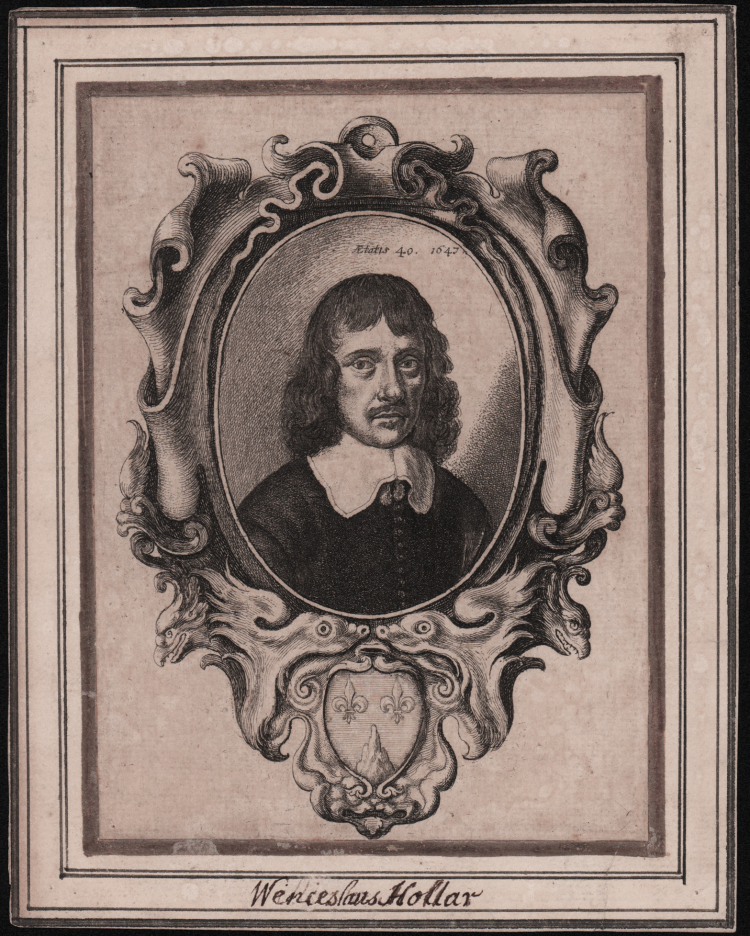



| Reference: | S42136 |
| Author | Wenzel HOLLAR |
| Year: | 1647 |
| Measures: | 130 x 165 mm |


| Reference: | S42136 |
| Author | Wenzel HOLLAR |
| Year: | 1647 |
| Measures: | 130 x 165 mm |
Self-portrait of Wenceslaus Hollar, head and shoulders facing front, wearing white collar over black buttoned doublet, within oval in decorated cartouche with heads of fantastic animals below, around his coat of arms.
Etching, 1647, a second state with the coat of arms replaced, but before Hollar's name added beneath coat of arms. Lettered above Hollar's head in oval "Ætatis 40. 1647".
Portrait related to the English period of the artist, who portrays himself at the age of 40 years.
A fine impression, printed on contemporary laid paper, trimmed to the platemark and laid down on antique cardboard, perfect condition. Rare.
Wenceslaus Hollar (July 23, 1607 - March 25, 1677) was a prolific 17th-century Bohemian graphic artist who spent much of his life in England. He is particularly known for his engravings and etchings. He was born in Prague, died in London, and was buried in St. Margaret's Church in Westminster. Hollar was one of the best and most prolific artists of his time. His work includes approximately 3000 etchings that include views, portraits, ships, religious subjects, heraldic subjects, landscapes and still lifes in many different forms.
Bibliografia
R. Godfrey, 'Wenceslaus Hollar: A Bohemian Artist in England', 1994, n. 72; The New Hollstein: German engravings, etchings and woodcuts 1400-1700 (985.II); Pennington 1982 A descriptive catalogue of the etched work of Wenceslaus Hollar (1420.II); O'Donoghue 1908-25 / Catalogue of Engraved British Portraits preserved in the Department of Prints and Drawings in the British Museum n. 4.
Wenzel HOLLAR (Praga 1607 – Londra 1677)
|
Wenceslaus Hollar (23 July 1607 – 25 March 1677) was a prolific and accomplished Bohemian graphic artist of the 17th century, who spent much of his life in England. He is particularly noted for his engravings and etchings. He was born in Prague, died in London, and was buried at St Margaret's Church, Westminster. After his family was ruined by the Sack of Prague in the Thirty Years' War, the young Hollar, who had been destined for the legal profession, decided to become an artist. The earliest of his works that have come down to us are dated 1625 and 1626; they are small plates, and one of them is a copy of a "Virgin and Child" by Dürer, whose influence upon Hollar's work was always great. In 1627 he was in Frankfurt where he was apprenticed to the renowned engraver Matthäus Merian. In 1630 he lived in Strasbourg, Mainz and Koblenz, where Hollar portrayed the towns, castles, and landscapes of the Middle Rhine Valley. In 1633 he moved to Cologne. It was in 1636 that he attracted the notice of the famous nobleman and art collector Thomas Howard, 21st Earl of Arundel, then on a diplomatic mission to the imperial court of Emperor Ferdinand II. Employed as a draftsman, he travelled with Arundel to Vienna and Prague. In Cologne in 1635, Hollar published his first book. In 1637 he went with Arundel to England, where he remained in the earl's household for many years. Hollar was one of the best and most prolific artists of his time. His work includes some 400 drawings and 3000 etchings. Hollar produced a variety of works. His plates number some 2740, and include views, portraits, ships, religious subjects, heraldic subjects, landscapes, and still life in many different forms. Hollar was known for his topographical works and his maps. These were often made after designs by other artists. He made a few maps of military engagements which were drawn by the Flemish artist and cartographer Jacob van Werden.
|
Wenzel HOLLAR (Praga 1607 – Londra 1677)
|
Wenceslaus Hollar (23 July 1607 – 25 March 1677) was a prolific and accomplished Bohemian graphic artist of the 17th century, who spent much of his life in England. He is particularly noted for his engravings and etchings. He was born in Prague, died in London, and was buried at St Margaret's Church, Westminster. After his family was ruined by the Sack of Prague in the Thirty Years' War, the young Hollar, who had been destined for the legal profession, decided to become an artist. The earliest of his works that have come down to us are dated 1625 and 1626; they are small plates, and one of them is a copy of a "Virgin and Child" by Dürer, whose influence upon Hollar's work was always great. In 1627 he was in Frankfurt where he was apprenticed to the renowned engraver Matthäus Merian. In 1630 he lived in Strasbourg, Mainz and Koblenz, where Hollar portrayed the towns, castles, and landscapes of the Middle Rhine Valley. In 1633 he moved to Cologne. It was in 1636 that he attracted the notice of the famous nobleman and art collector Thomas Howard, 21st Earl of Arundel, then on a diplomatic mission to the imperial court of Emperor Ferdinand II. Employed as a draftsman, he travelled with Arundel to Vienna and Prague. In Cologne in 1635, Hollar published his first book. In 1637 he went with Arundel to England, where he remained in the earl's household for many years. Hollar was one of the best and most prolific artists of his time. His work includes some 400 drawings and 3000 etchings. Hollar produced a variety of works. His plates number some 2740, and include views, portraits, ships, religious subjects, heraldic subjects, landscapes, and still life in many different forms. Hollar was known for his topographical works and his maps. These were often made after designs by other artists. He made a few maps of military engagements which were drawn by the Flemish artist and cartographer Jacob van Werden.
|